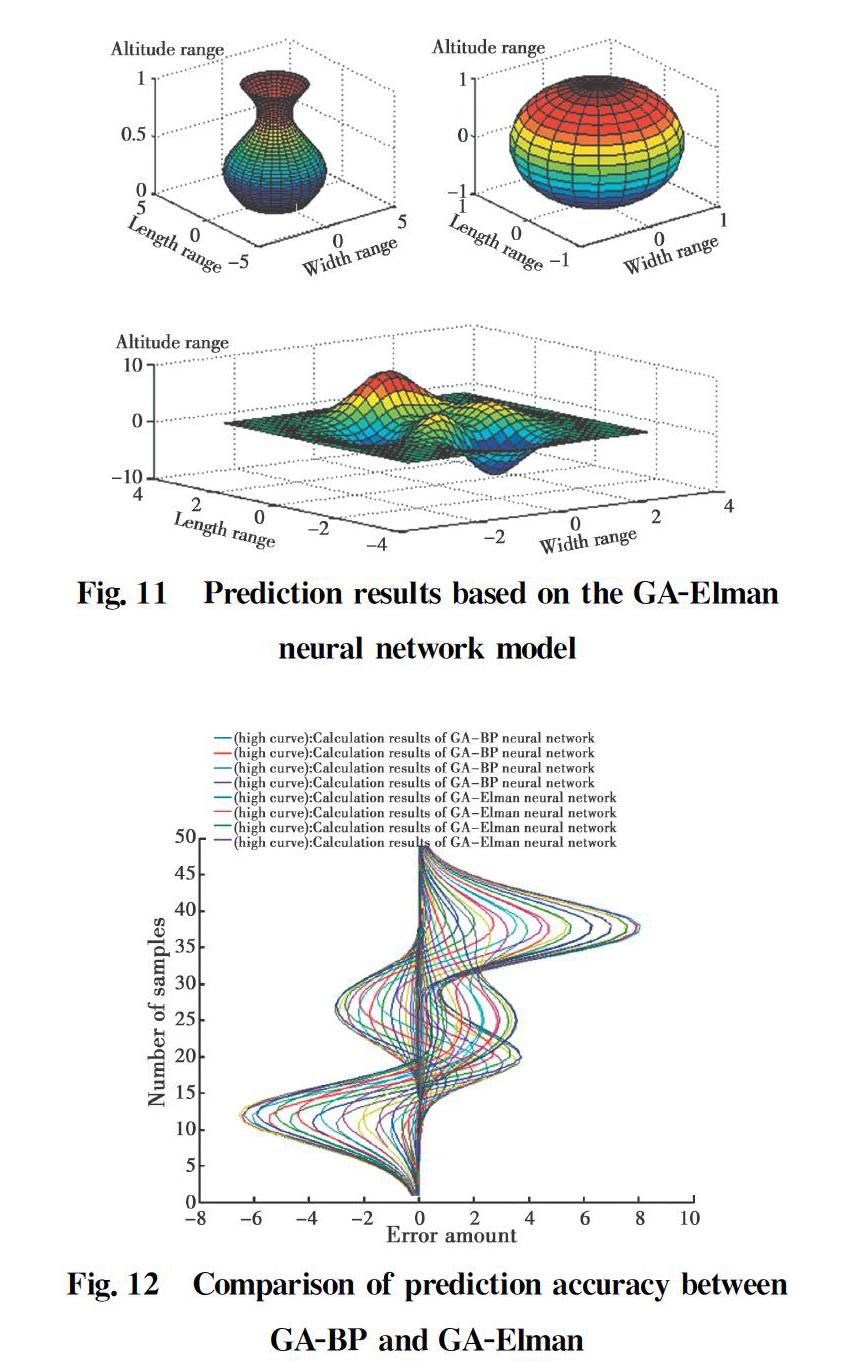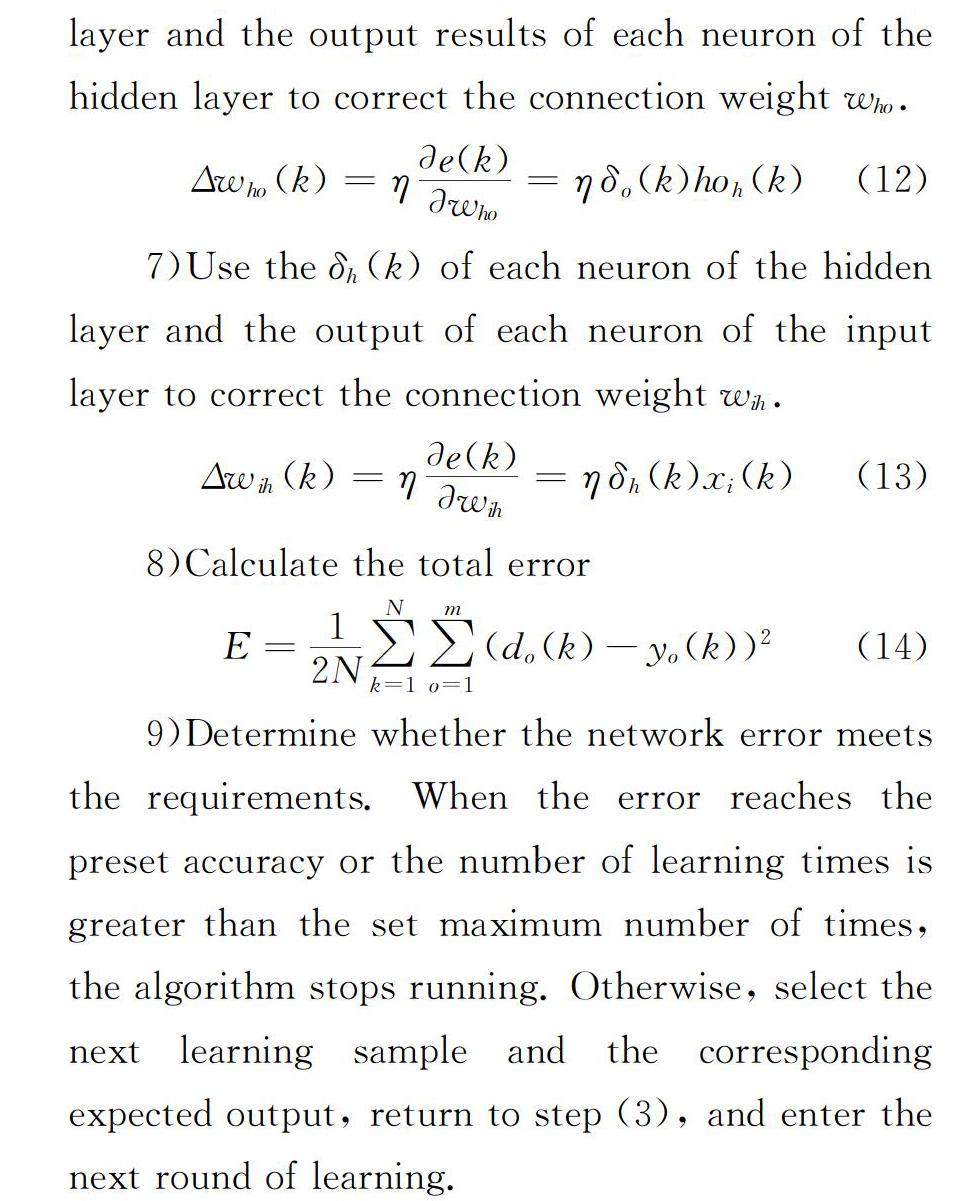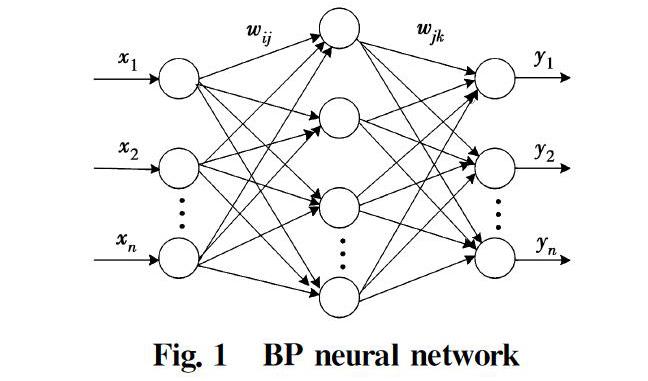基于遗传模拟退火算法的滑坡位移预测方法
2021-03-11乔世范王超
乔世范 王超



摘 要:滑坡是一種常见的地质灾害,通常在复杂的地质条件下演化和发生,给社会和人类的生命财产安全造成了极大的危害。了解滑坡的发展规律,对灾害防治具有重要意义。在现有滑坡累积位移时间序列的基础上,提出了一种基于遗传模拟退火算法的滑坡位移预测方法。采用遗传模拟退火算法BP神经网络对白水河滑坡预警区Z118观测点进行分析,利用前3个月的累积位移来预测第4个月的累积位移。分别与BP神经网络模型和Elman神经网络模型进行比较,并将遗传模拟退火算法的预测结果与支持向量机的预测结果进行比较。研究结果表明,建立的滑坡位移预测模型能有效地提高预测精度。
关键词:滑坡;位移预测;遗传模拟退火算法;神经网络;支持向量机
1 Introduction
The landslide is a natural phenomenon in which the rock or soil in the slope slides or collapses as a whole due to the influence of factors such as gravity, groundwater, rainfall, earthquake, human activities and others. The occurrence of a landslide is always accompanied by a shear failure surface. Landslide analysis studies the evolution, the probability of occurrence and the mechanism of the landslide on the basis of fully understanding the geological body. There are both qualitative and quantitative methods of landslide analysis. Quantitative analysis methods are further divided into deterministic analysis and uncertainty analysis.
The constitutive model is based on the viscoelastic assumption of the sliding body and the sliding surface[1]. The concept of viscous force is introduced into the dynamic equation of landslide displacement. Under the assumption of the infinite slope, the solution of the dynamic equation and the practical significance of the solution are discussed. On this basis, the landslide displacement prediction equation is established with the time and the tangential stress ratio as variables[2]. In 2004, Ferlisi[3] considered the influence of the change in the groundwater level on the landslide, and established a mechanical model of landslide displacement to predict the time a landslide would occur based on the viscoplasticity of the sliding surface. In 2005, based on the study of Angeli and Casparto, Spanish scholars Corominas et al.[4] further analyzed the characteristics of the Vallcebre landslide by the step system, and pointed out the importance of viscous force in the process of landslide sliding. The method and conclusion of calculating the viscous force with different ideas were introduced into landslide prediction, and the deformation velocity of the landslide was successfully predicted. In 2006, Maugeri[5] proposed coupling elasticity and plasticity. A mathematical model of the viscous constitutive relationship could be used to predict the viscous deformation of the landslide and the slope of various slip modes.
Due to the complex and unpredictable evolution characteristics of the landslide system, it is difficult to accurately predict the displacement of the large complex landslide using traditional methods of analysis. In order to solve this problem, scholars have done much research. Zhang et al[6] carried out laboratory tests and field macro deformation analysis, and divided the evolution of the landslide into three stages: initial creep, constant creep and accelerated creep. The creep rate and sliding time of the landslide were analyzed, based on this, and the empirical formula for predicting landslide displacement was established[6-8]. Fukuzono[9] and Voight[10] introduced a method to predict the time of a volcanic eruption into the study of landslide prediction, and established an empirical formula for calculating the velocity and acceleration of the landslide displacement. They concluded that the two variables had an exponential relationship based on previous studies, Federico et al.[11] proposed a general expression of the creep model considering displacement, velocity and acceleration. Inspired by the growth model of organisms, Verhulst, a German biologist, proposed a landslide prediction model based on creep theory, named the Verhulst model[12]. On the basis of Verhulst's research[12], Shu and Xiao[13] improved the Verhulst model by combining the geological characteristics of landslide evolution with the quadratic regression fitting method and grey theory to characterize the deformation of the landslide. Smith et al.[14] proposed a mathematical model for landslide prediction based on catastrophe theory to predict the time slope instability would occur. A series of nonlinear prediction models such as the fractal prediction model[15], the loading and unloading response ratio prediction model[16] and the slope instability prediction model based on creep theory[17-20] were also proposed. Although these nonlinear models achieved good results in predicting the time a landslide would occur, they are still in the development stage. It is necessary to further analyze the nonlinear characteristics of the landslide. Therefore, according to the actual situation of the landslide, the nonlinear theory is introduced for modeling and analysis. Based on this, the Support Vector Machine method is applied in this article to establish the landslide stability evaluation model, which avoids the limitations of traditional methods and improves the accuracy of the evaluation. At the same time, the neural network is applied to the landslide displacement prediction. Based on the time series of the cumulative displacement of the landslide, the Genetic Simulated Annealing (GSA) algorithm is applied to the modelling and analysis of the landslide displacement. Considering the influence of rainfall on landslide displacement, the dynamic neural network (Elman network) is used, and the Genetic Algorithm is used to optimize the initial weight of the network to predict the cumulative displacement of the landslide under rainfall conditions. The simulation results show that the method can improve the accuracy of the prediction and provide a new idea for the design and construction of geotechnical engineering.
2 Landslide displacement prediction model based on the neural network optimized by the GSA algorithm
The artificial neural network (ANN) has developed rapidly in recent years. As a general nonlinear approximator, it has been widely used in pattern recognition, classification and identification of nonlinear systems. Compared with other statistical methods, the artificial neural network has many advantages and is an effective method of predicting complex nonlinear dynamic systems. It is also suitable for landslide prediction. At present, the BP neural network, which can reveal the nonlinear relationship in data samples, is the most widely used artificial neural network. A large number of processing units constitute a nonlinear adaptive dynamic system, which has good adaptability, self-organization and strong learning, association, fault tolerance and anti-interference ability. The BP neural network model was proposed by Rumelhart in 1986[21]. Because of its simple structure, adjustable parameters, many training algorithms and good operability, it is widely welcomed by scholars. However, the BP neural network model has some shortcomings. For example, if the convergence speed is too slow in the late stage of learning, it easily falls into local minima, which makes it hard to determine the network structure. In addition, the initial weights cannot accurately get the initial weights of the network. In view of these characteristics, this article combines the Genetic Algorithm (GA) and Simulated Annealing (SA) to optimize the weights of the neural network. A landslide displacement prediction model based on the GSA algorithm optimized BP neural network is proposed and applied to the displacement prediction of the Baishui River landslide. The weights of the BP neural network before and after optimization are compared, and the prediction effect before and after optimization is compared using the Support Vector Machine method. It is verified that the landslide displacement prediction model optimized by the BP neural network based on the GSA algorithm has high prediction accuracy for the time series of cumulative landslide displacement, which can meet the needs of engineering construction.
2.1 BP neural network
The BP neural network is essentially a feed-forward neural network. Its main features are forward signal transmission and reverse error transmission. If the output layer does not receive the expected result, the signal will be sent back and the calculation will restart by adjusting the weight and threshold of the network according to the error. The above algorithm allows the continuous update of the BP neural network so that the output results gradually approach the expected results. The topological structure of the single hidden layer BP neural network is shown in Fig. 1.
Assume that the BP neural network in Fig. 1 has n neurons in the input layer, p neurons in the hidden layer and m neurons in the output layer, which are defined as follows. The meanings of parameters are listed in Table 1.
According to references[22-24], the basic steps of the BP neural network model are as follows.
1)Initialize the network. Assign a random number in the interval (-1, 1) to each connection weight, set the error function e, and determine the calculation accuracy and the maximum number of learning M.
2)Select the input sample k randomly x(k)=(x1(k),x2(k),…,xn(k))′, and the corresponding expected output d(k)=(d1(k),d2(k),…,dm(k))′.
3)Calculate the input and output results of each neuron in the hidden layer and the output layer.
4)Calculate the partial derivative δo(k) of the error function to each neuron in the output layer by using the expected output and actual output of the network.
5)Calculate the partial derivative δh(k) of the error function of each neuron in the hidden layer based on the connection weight from the hidden layer to the output layer, the partial derivative δo(k) of each neuron in the output layer and the output results of the hidden layer is
6)Use the δo(k) of each neuron of the output layer and the output results of each neuron of the hidden layer to correct the connection weight who.
7)Use the δh(k) of each neuron of the hidden layer and the output of each neuron of the input layer to correct the connection weight wih.
8)Calculate the total error
9)Determine whether the network error meets the requirements. When the error reaches the preset accuracy or the number of learning times is greater than the set maximum number of times, the algorithm stops running. Otherwise, select the next learning sample and the corresponding expected output, return to step (3), and enter the next round of learning.
2.2 GA-Elman neural network model
The GA-Elman neural network model is used to predict the time series of the landslide. The network is composed of the correlation layer, input layer, hidden layer and output layer. There is a corresponding relationship between the neurons in the correlation layer and the neurons in the hidden layer, and the output value of the hidden layer is delayed and fed back to the correlation layer. In general, the two layers of the Elman can reflect the state of the network. The GA-Elman network contains a correlation layer. The hidden layer of the GA-Elman network is connected with the full feedback of the correlation layer. It can describe any n-order system which has been proved theoretically. In order to improve the dynamic performance of the GA-Elman neural network, a self-feedback connection is introduced into the correlation layer of the GA-Elman neural network. The structure of the improved GA-Elman neural network is shown in Fig.2. In the graph, the number of neurons in the correlation layer is equal to the number of neurons in the hidden layer. The number of external input neurons is the number of features. The hidden layer nodes are fully connected to the input layer and the output layer.
The Levenberg-Marquarelt (LM) algorithm, which has a fast convergence speed, is a common algorithm in neural network training. In the case of high accuracy requirements, the advantages of the algorithm are particularly prominent. In most cases, the LM algorithm can obtain smaller mean square error than any other algorithm. Like the Newton algorithm, this algorithm can avoid computing the Hessian matrix when it is corrected at the second-order training rate.
2.3 Establishment of the GA-Elman neural network model
In this study, a neural network model (p, h, 1) is established. Since only the landslide displacement is predicted, the output unit of the GA-Elman neural network has just one neuron. The model is established as follows.
1) Initialize the weight of the Elman network as a random number between intervals [0, 1], which is encoded by the GA.
2) Generate an initial population with a population size of N.
3) Decode every population in the group which represents an Elman network structure. The N sets of weights obtained by this decoding correspond to N networks of the same structure.
4) For each network, the network structure is adjusted as follows.
a. Identify training samples and test samples for the network.
b. Calculate the network output corresponding to the input sample set based on the Levenberg-Marquarelt (LM) algorithm.
c. Determine the fitness function as the reciprocal of the network's error performance function. Calculate the fitness of each chromosome, the larger the error value, the smaller the corresponding fitness.
d. Select individuals with high fitness as new parents and eliminate individuals with small fitness.
e. Cross and mutate the new parent.
f. Repeat steps c~e to perform a new iteration of the new population until the training target meets the requirement and a set of optimization weights is obtained.
5) Assign the optimized weight to the Elman network for modeling and prediction.
The error evolution curve of the Genetic Algorithm is shown in Fig. 4.
3 Case analysis of the landslide under the rainfall condition
Landslide displacement is usually affected by many factors, such as geotechnical mechanical properties, geological profile, hydrological conditions and so on. However, due to the limitation of manpower and material resources, it is impossible to conduct a comprehensive study of the influence of the above factors. Since rainfall plays an important role in the generation of landslides, this article mainly studies the influence of rainfall on landslide displacement. In order to ensure that the research results are not affected by other factors, before the case analysis, the other factors remain unchanged. Based on these requirements, the neural network prediction model was established. Since the engineering geology of the Baishui River landslide satisfies the conditions for verifying the relationship between landslide displacement and rainfall, the Baishui River landslide was selected as the study object.
The displacement observation data of the Baishui River landslide are shown in Fig.7. Since May 1, 2015, the data was recorded every other month. As of June 1, 2017, 47 sets of data were recorded. Each time step in Fig. 7 represents a month. In this case, the GA-Elman neural network model was used. Since the occurrence of a landslide is a long-term cumulative process, the displacement of a landslide will affect the evolution of the next landslide. Based on this, the rainfall and the accumulated displacement in each period are used as the input value, and the output result is set as the predicted value of the cumulative displacement at the next time. The results show that, in most cases, the influence of rainfall on the landslide has a certain lag. Therefore, in order to predict the cumulative displacement of the landslide in Δt period and ensure the accuracy of the prediction results by considering the influence of the actual rainfall, the Δt period is divided into t1-t2 period, t2-t3 period, t3-t4 period and t4-t5 period, and the rainfall of time t1, time t2, time t3, time t4 and time t5 are used as input values. The first 37 groups of data are used for the training network, and the last 10 groups of data are used for the prediction. The corresponding coefficients are set in the model, and the number of neurons in the hidden layer is determined by experience and experiment. After many experiments, it can be determined that when the number of neurons in the hidden layer is 15, the mean square error and the fault-tolerant function of the network achieve the best effect.
In order to prove the superiority of this method, the initial weights and thresholds of the Elman network are optimized by the Genetic Algorithm, and compared with the results of the non-optimized Elman network. The error performance curve of the Elman network with random initial weights is shown in Fig.8. In addition, the Elman network and the BP network are compared. The error performance curve of the BP network optimized by the Genetic Algorithm is shown in Fig.9. Through comparison, it can be seen that the Elman network has better performance than the BP network, and the prediction effect of the optimized Elman network is better than that of the non-optimized Elman network.
In Fig.2, x represents the independent variable, y represents the learning rate, and z represents the algorithm performance. In order to get better prediction results, first, the collected data are logarithmically processed, and then normalized. The prediction results using the optimized Elman network model are shown in Table 2 and Fig.10.
It can be seen from Table 2 that the predicted value of the cumulative landslide displacement is very close to the measured value, and the relative error is less than 4%. In the actual training process, 73% of the data passed the training. In the case with the same parameters and where the mean square error of the performance index meets the requirements, the convergence process of the Elman neural network optimized by the Genetic Algorithm is smoother and faster than the original algorithm, and the accuracy of the prediction is enough to meet the needs of the medium and short-term prediction of the landslide displacement. The results of numerical simulation analysis show that the shorter the prediction time, the greater the prediction accuracy. Therefore, the same samples are used to train the GA-BP neural network to verify the superiority of the Genetic Simulated Annealing algorithm. The prediction results are shown in Fig.11. It can be seen from Fig.12 that the prediction accuracy of the GA-BP neural network is significantly lower than that of the GA-Elman neural network. Therefore, the GA-Elman neural network is better than the GA-BP neural network in the prediction of landslide displacement under the rainfall condition, so the GA-Elman neural network should be used first.
4 Conclusions
Based on the existing time series of the accumulated displacement of the landslide, a BP neural network prediction model based on the Genetic Simulated Annealing algorithm was proposed. The weight of the network was optimized using the Genetic Simulated Annealing algorithm to overcome shortcomings of the BP neural network, such as slow convergence speed and easy to fall into the local minimum point. The GSA-BP neural network was used to analyze the observation point Z118 in the Baishui River landslide warning area, and the landslide displacement in the 4th month was predicted using the cumulative landslide displacement of the first 3 months. The prediction results were compared with those of the BP neural network and the Elman neural network, respectively. At the same time, the prediction results of the Genetic Simulated Annealing algorithm and the Support Vector Machine model were compared and analyzed. The results showed that the prediction effect of the GSA-BP neural network was very good. In addition, the prediction model established in this article performed well in the average relative error and the mean square error of the prediction results, proving the rationality of the model. The GA-Elman neural network was used to analyze the landslide, and the generalized predictive control fast algorithm was used to realize the control of the landslide prediction. From the point of view of dynamics, taking the landslide thrust as the control variable, the simulation test proves that the method can well control the prediction accuracy of landslide displacement, ensuring the accuracy of the landslide displacement prediction, which can provide reliable data support for landslide prediction, and ensure the development and completion of landslide prevention and control.
Acknowledgements
The authors would like to acknowledge the financial support from Key Projects Supported by China Railway Corporation (No. 2017G007-D, 2017G008-J). References:
[1] DAI M, TANG D B, GIRET A, et al. Energy-efficient scheduling for a flexible flow shop using an improved genetic-simulated annealing algorithm [J]. Robotics and Computer-Integrated Manufacturing, 2013, 29(5): 418-429.
[2] BI R N, EHRET D, XIANG W, et al. Landslide reliability analysis based on transfer coefficient method: a case study from Three Gorges Reservoir [J]. Journal of Earth Science, 2012, 23(2): 187-198.
[3] FERLISI S. A simple mechanical model for the interpretation of translational active landslides involving detrital covers [M]// Landslides: Evaluation and Stabilization/Glissement de Terrain: Evaluation et Stabilisation, Set of 2 Volumes. CRC Press, 2004: 1227-1232.
[4] COROMINAS J, MOYA J, LEDESMA A, et al. Prediction of ground displacements and velocities from groundwater level changes at the Vallcebre landslide (Eastern Pyrenees, Spain) [J]. Landslides, 2005, 2(2): 83-96.
[5] MAUGERI M, MOTTA E, RACITI E. Mathematical modelling of the landslide occurred at Gagliano Castelferrato (Italy) [J]. Natural Hazards and Earth System Sciences, 2006, 6(1): 133-143.
[6] ZHANG Q C, SUN Q S. Damage detection of self-anchored suspension bridge based on neural network model and genetic-simulated annealing algorithm [J]. Advanced Materials Research, 2011, 243-249: 1963-1967.
[7] ZHENG X J. Optimal dispatching methods for unit commitment based on hybrid genetic-simulated annealing algorithm [J]. Applied Mechanics and Materials, 2013, 462/463: 1076-1080.
[8] YI P Y, WANG K, REN J, et al. Research on anti-analysis of the landslide′s strength parameter through transferring coefficient method [J]. The Chinese Journal of Geological Hazard and Control, 2008, 19(4): 23-26, 32. (in Chinese)
[9] FUKUZONO T. A new method for predicting the failure time of a slope [C] // Proceedings of the 4th International Conference and Field Workshop on Landslides. Tokyo: Tokyo University Press, 1985: 145-150.
[10] VOIGHT B. A method for prediction of volcanic eruptions [J]. Nature, 1988, 332(6160): 125-130.
[11] FEDERICO A, POPESCU M, FIDELIBUS C, et al. On the prediction of the time of occurrence of a slope failure: a review [M]// Landslides: Evaluation and Stabilization/Glissement de Terrain: Evaluation et Stabilisation, Set of 2 Volumes. CRC Press, 2004: 979-983.
[12] HE X H, WANG S J, XIAO R H, et al. Improvement of Verhulst forecast model of landslide and its application [J]. Rock and Soil Mechanics, 2013, 34(Sup1): 355-364.(in Chinese)
[13] SHU Q, XIAO X P. Combination forecasting model using grey verhulst models coupling to regression analysis [C]//Proceedings of the 2016 International Conference on Applied Mathematics, Simulation and Modelling. May 28-29, 2016.
[14] SMITH C E, ARNETT D K, TSAI M Y, et al. Physical inactivity interacts with an endothelial lipase polymorphism to modulate high density lipoprotein cholesterol in the GOLDN study [J]. Atherosclerosis, 2009, 206(2): 500-504.
[15] SWANEY R E, GROSSMANN I E. An index for operational flexibility in chemical process design. Part I: Formulation and theory [J]. AIChE Journal, 1985, 31(4): 621-630.
[16] NIMKUNTOD P, TONGDEE P. Plasma low-density lipoprotein cholesterol/high-density lipoprotein cholesterol concentration ratio and early marker of carotid artery atherosclerosis [J]. Journal of the Medical Association of Thailand, 2015, 98(Sup 4): S58-S63.
[17] ZHANG Q, GROSSMANN I E, SUNDARAMOORTHY A, et al. Data-driven construction of Convex Region Surrogate models [J]. Optimization and Engineering, 2016, 17(2): 289-332.
[18] HAMDIA K M, LAHMER T, NGUYEN-THOI T, et al. Predicting the fracture toughness of PNCs: a stochastic approach based on ANN and ANFIS [J]. Computational Materials Science, 2015, 102: 304-313.
[19] BADAWY M F, MSEKH M A, HAMDIA K M, et al. Hybrid nonlinear surrogate models for fracture behavior of polymeric nanocomposites [J]. Probabilistic Engineering Mechanics, 2017, 50: 64-75.
[20] KHALIQ A Q M, BIALA T A, ALZAHRANI S S, et al. Linearly implicit predictor-corrector methods for space-fractional reaction-diffusion equations with non-smooth initial data [J]. Computers & Mathematics with Applications, 2018, 75(8): 2629-2657.
[21] BASHEER I A, HAJMEER M. Artificial neural networks: fundamentals, computing, design, and application [J]. Journal of Microbiological Methods, 2000, 43(1): 3-31.
[22] MARTIN T H, HOWARD B D, MARK B. Neural network design [M]. Machinery Industry Press, 2002.
[23] SIMON H. Principle of neural network [M]. Machinery Industry Press, 2004.
[24] ZHU K, WANG Z L. Proficient in MATLAB neural network [M]. Electronic Industry Press, 2010.
[25] LI D Y. Prediction study of landslides with step-like deformation in the Three Gorges Reservior [D]. Wuhan: China University of Geosciences, 2010.
[26] DU J, YIN K L, LACASSE S. Displacement prediction in colluvial landslides, Three Gorges Reservoir, China [J]. Landslides, 2013, 10(2): 203-218.
[27] HUANG F, YIN K, HE T, et al. Influencing factor analysis and displacement prediction in reservoir landslides-a case study of Three Gorges Reservoir (China) [J]. Tehnicki Vjesnik - Technical Gazette, 2016, 23(2): 617-626.
[28] GUO Z Z, YIN K L, HUANG F M, et al. Landslide displacement prediction based on surface monitoring data and nonlinear time series combination model [J]. Chinese Journal of Rock Mechanics and Engineering, 2018, 37(Sup1): 3392-3399.(in Chinese)
(編辑 章润红)
